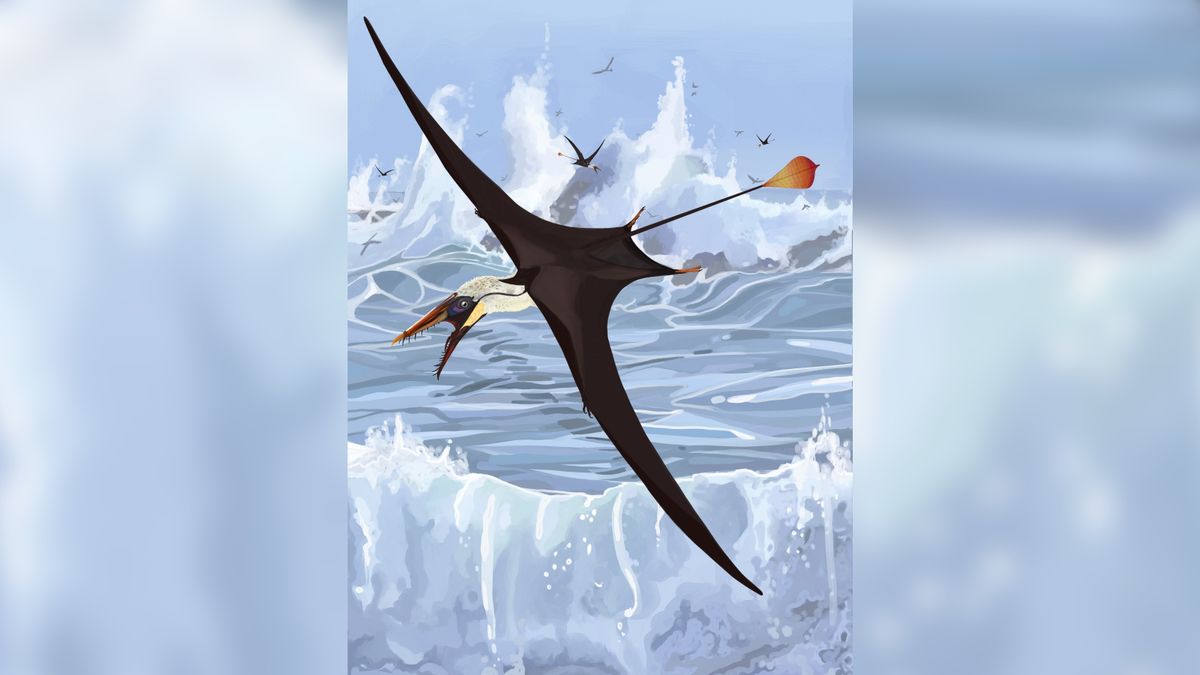The first pterosaurs took flight during the age of dinosaurs thanks to a sail-like tensioning system, a new study has found.
Early pterosaurs — informally called “pterodactyls” — had long tails with thin, leaf-shaped flaps of tissue on the end called vanes. This vane would have compromised their flight if it were floppy and fluttered like a flag, so paleontologists knew it was stiff, but they didn’t know how the vane maintained stiffness until now.
Researchers used high-powered lasers to study skin and other soft tissues preserved in pterosaur tail fossils. They found that the vane had criss-crossing fibres and tube-like structures that would have supported a sophisticated tensioning system, according to the study.
The team believes that the tensioning system would have allowed the vane to act like a ship’s sail, becoming tense when the wind blew through it so the creature could steer, according to a statement released Jan. 7.
“It never ceases to astound me that, despite the passing of hundreds of millions of years, we can put skin on the bone of animals we will never see in our lifetimes,” study lead author Natalia Jagielska, who was a doctoral student at the University of Edinburgh in the U.K. during the study and is now a curator at Lyme Regis Museum in the U.K., said in the statement.
Related: Jurassic ‘mist wing’ fossil discovered on Scottish island could be missing link in pterosaur evolution
Pterosaur flight has a long history of baffling paleontologists. In the 18th century, fossilized pterosaur wings were misidentified as the paddles of marine creatures and, in the 19th century, as the wings of giant flying marsupials. Today, scientists know that pterosaurs were flying reptiles that flapped their wings like birds and bats.
For the new study, researchers looked at more than 100 early pterosaur fossils with an ultraviolet flashlight to identify specimens with exceptionally well-preserved tail vanes. They then applied a laser technique called laser simulated fluorescence to these vanes, which created maps of the vane’s internal structures, according to the study.
Dave Martill, a pterosaur researcher and emeritus professor at the University of Portsmouth who was not involved in the study, told Live Science in an email that he thought the study was “innovative” and complimented the researchers for studying the vane in such detail.
“Previously it had been seen merely as a flap of (probably stiffened) skin,” Martill said. “It seems that it is rather more than that, and has internal structure that likely reflects a rather more complex function.”
The tensioning system used to maintain vane stiffness for flight would have also allowed the animal to use it for display purposes, such as attracting a mate, the study authors found.
Losing the tail
Pterosaurs emerged with long tails towards the end of the Triassic Period (251.9 million to 201.3 million years ago), but their tails got smaller over time and were almost gone by the time pterosaurs went extinct alongside dinosaurs at the end of the Cretaceous period (145 million to 66 million years ago).
Martill noted that a group of pterosaurs called Pterodactyloidea — the group that the name “pterodactyl” comes from — significantly reduced their tail length in the Jurassic period (201.3 million to 145 million years ago), which likely improved their mobility in the air and helped the group diversify.
“Generally, long tails are detrimental for flight,” Martill said. “Although they look sexy [as is the case for the peacock], they get in the way of flying.”
The researchers published their findings on Dec. 18, 2024 in the online journal eLife. Unlike traditional scientific journals, eLife doesn’t have a peer-review process that rejects studies before publication, but instead publishes preprints with a public peer-review assessment.


